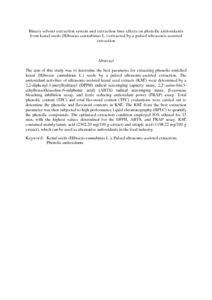Citation
Wong, Yu Hua and Lau, Hwee Wen and Tan, Chin Ping and Long, Kamariah and Nyam, Kar Lin
(2014)
Binary solvent extraction system and extraction time effects on phenolic antioxidants from kenaf seeds (Hibiscus cannabinus L.) extracted by a pulsed ultrasonic-assisted extraction.
The Scientific World Journal, 2014.
art. no. 789346.
pp. 1-7.
ISSN 2356-6140; ESSN: 1537-744X
Abstract
The aim of this study was to determine the best parameter for extracting phenolic-enriched kenaf (Hibiscus cannabinus L.) seeds by a pulsed ultrasonic-assisted extraction. The antioxidant activities of ultrasonic-assisted kenaf seed extracts (KSE) were determined by a 2,2-diphenyl-1-picrylhydrazyl (DPPH) radical scavenging capacity assay, 2,2′-azino-bis(3-ethylbenzothiazoline-6-sulphonic acid) (ABTS) radical scavenging assay, β-carotene bleaching inhibition assay, and ferric reducing antioxidant power (FRAP) assay. Total phenolic content (TPC) and total flavonoid content (TFC) evaluations were carried out to determine the phenolic and flavonoid contents in KSE. The KSE from the best extraction parameter was then subjected to high performance l.quid chromatography (HPLC) to quantify the phenolic compounds. The optimised extraction condition employed 80% ethanol for 15 min, with the highest values determined for the DPPH, ABTS, and FRAP assay. KSE contained mainly tannic acid (2302.20 mg/100 g extract) and sinapic acid (1198.22 mg/100 g extract), which can be used as alternative antioxidants in the food industry.
Download File
![[img]](http://psasir.upm.edu.my/36634/1.hassmallThumbnailVersion/Binary%20solvent%20extraction%20system%20and%20extraction%20time%20effects%20on%20phenolic%20antioxidants%20from%20kenaf%20seeds.pdf)  Preview |
|
PDF (Abstract)
Binary solvent extraction system and extraction time effects on phenolic antioxidants from kenaf seeds.pdf
Download (75kB)
| Preview
|
|
Additional Metadata
Actions (login required)
 |
View Item |

